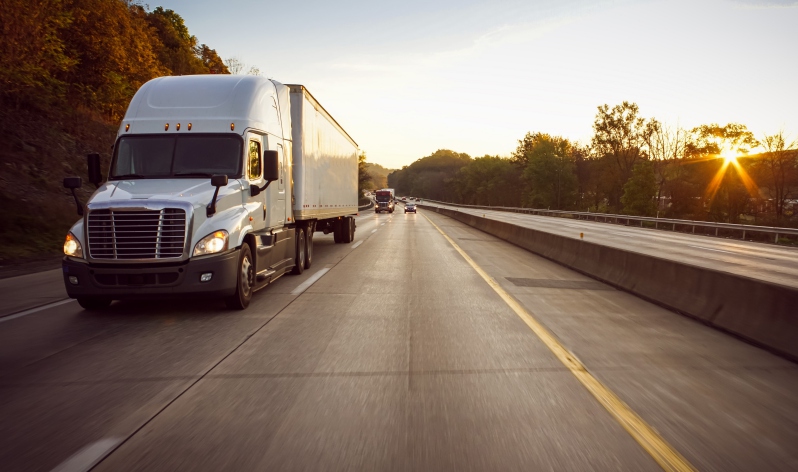
State and local governments compete and cooperate to attract autonomous vehicle developers.
One morning, two tractor trailers drove away from a loading dock in Pittsburgh. A human drove the leading truck, and the one tailing behind autonomously followed along using cameras, connectivity technology, and automated driving systems. Over the course of two days, this “truck platoon” made it to Detroit and back to Pittsburgh, stopping only to unload its cargo at a food bank.
In the distant future, truck platooning and autonomous vehicle technology promise greater efficiency and mobility. In the short term, autonomous vehicle testing creates local jobs. State and city governments are trying to attract autonomous vehicle companies to test their new technologies but face political and regulatory challenges. Until the federal government provides a unified framework for assuring the safety of autonomous vehicles, states and local governments must assess risk, manage public expectations, and work together with neighboring jurisdictions to harmonize regulation.
Mark Kopko, director of the Office of Transformational Technology in the Pennsylvania Department of Transportation, explained in an interview that each state must have its own regulation. But Kopko emphasized that states should work together to make sure that autonomous vehicles can seamlessly move from one state to the next.
In fact, the test run from Pittsburgh to Detroit was the result of a collaboration between Locomotion, a Pittsburgh-based autonomous vehicle company, and the Smart Belt Coalition, a longstanding partnership between multiple states’ departments of transportation, turnpike commissions, and academic institutions.
The automotive industry has a long history of managing differences in safety regulations between jurisdictions. State and local regulations exist alongside federal rules governing autonomous vehicle testing and deployment. Twenty-nine states have recently enacted legislation related to vehicle driver definition updates and commercial requirements related to truck platooning.
Regulatory permitting for general autonomous vehicle testing is less common. Even in California, a leader in autonomous vehicle testing, prohibits operation of a vehicle without a driver prepared to take control of the vehicle and prohibits compensating autonomous vehicle testers for providing rides to members of the public.
Arizona, Nevada, Massachusetts, Michigan, and Pennsylvania are state leaders in developing laws related to the permitting and deployment of autonomous vehicles. States that have passed legislation in this area tend to be accommodating to autonomous vehicle developers, as states lawmakers often believe they are in competition with other states for the location of new development and economic growth.
Passing permissive regulation and developing local government expertise related to autonomous vehicles is an increasingly common approach to attracting autonomous vehicle companies to a particular locality. The Mayor of Pittsburgh, William Peduto, has reportedly said that when autonomous vehicle companies choose a location for testing, they are seeking both regulatory clarity and local authorities who have experience governing and accommodating autonomous vehicle testing. According to Mayor Peduto, by the time that autonomous vehicle companies were looking for a commercial proving ground, the City of Pittsburgh already had years of experience making allowances for autonomous vehicle testing near Carnegie Mellon University’s Robotics Institute.
Autonomous vehicle companies seeking a place to test new products find a favorable environment in Pittsburgh. The Pennsylvania Department of Transportation offers permits for on road testing with few requirements other than submission of a safety self-assessment report which most companies already develop to meet federal guidelines set by the National Highway Transportation Safety Administration. The safety report required in Pennsylvania must include a description of the weather, maximum speeds, location types, and road conditions.
Pittsburgh requires a yearly report describing the location of testing, the number of crashes that cause injury or more than $5,000 of damage, and the number of jobs supported by the testing. The city uses this information to herald the creation of local jobs and to communicate with local residents about where they can expect to see autonomous vehicles.
The information collected by Pennsylvania and the City of Pittsburgh is not likely to be enough to form the basis of a public safety analysis. The RAND corporation estimates that using on-road testing alone would take more than 500 years at current testing rates to show that autonomous vehicles are as safe as human drivers. The same RAND study concluded that autonomous vehicles “cannot drive their way to safety” and suggested that more rigorous data needs to be collected.
California has adopted a similar approach to Pennsylvania and Pittsburgh but requires companies that wish to test autonomous vehicles to report slightly more detailed information. The California Department of Motor Vehicles requires that any operator of an autonomous vehicle within the state obtain a permit and have extensive personal accident and liability insurance. California also requires autonomous vehicle developers to report all collisions and instances where a human safety back up driver re-takes control of the vehicle.
Despite criticisms of California’s requirement to report autonomous vehicle failures, more than 50 companies hold testing permits in the state. However, when reporting these issues, autonomous vehicle developers still report almost no safety relevant information about each incident. They only report high level information such as number of vehicles involved and whether the autonomous vehicle was moving or stopped.
The approach taken by most state and local governments grants broad permission to test new technologies on public roads, and it provides limited oversight that does not significantly limit autonomous vehicle developers. Too much focus on accommodating new industry growth, however, can sometimes end in disaster.
For instance, according to a report from the National Transportation Safety Board, Arizona’s relaxed permitting process contributed to a fatal crash in 2018. The accident in Arizona demonstrates that although there are opportunities at the state and local level for development of autonomous vehicles, a favorable regulatory environment is not without risk.



